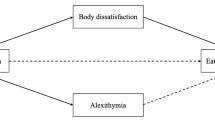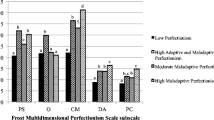Abstract
OBJECTIVE: This work aimed to explore the relationship between alexithymia and maladaptive perfectionism in the psychological process leading to eating disorders (ED). METHOD: Forty-nine individuals with ED and 49 controls completed the Concern over Mistakes subscale of the Frost Multidimensional Perfectionism Scale, the Perfectionism subscale of the Eating Disorders Inventory, the total score of the Toronto Alexithymia Scale, and the Drive for Thinness, Bulimia, and Body Dissatisfaction subscales of the Eating Disorders Inventory. We tested a model in which alexythimia is the independent variable and perfectionism is the possible mediator or moderator. RESULTS: Analyses confirmed the assumed model. In addition, it emerged that perfectionism played a mediating or moderating role when measured by different instruments. This result suggested that different instruments measured subtly different aspects of the same construct. DISCUSSION: Results could suggest that alexithymia is a predisposing factor for perfectionism, which in turn may lead to the development of eating disorders.
Similar content being viewed by others
References
Sifneos PE. The prevalence of alexithymic characteristics in psychosomatic patients. Psychother Psychosom 1973; 22: 255–62.
Taylor GJ. Eating disorders. In: Taylor GJ, Bagby RM, Parker JDA (Eds) Disorders of affect regulation: Alexithymia in medical and psychiatric illness. Cambridge, Cambridge University Press, 1997, pp 190–215.
Bagby RM, Taylor GJ. Measurement and validation of the alexithymia construct. In: Taylor GJ, Bagby RM, Parker JDA (Eds) Disorders of affect regulation: Alexithymia in medical and psychiatric illness. Cambridge, Cambridge University Press, 1997, pp 26–45.
Cochrane CE, Brewerton TD, Wilson DB, et al. Alexithymia in eating disorders. Int J Eat Disord 1993; 14: 219–22.
Schmidt U, Jiwany A, Treasure J. A controlled study of alexithymia in eating disorders. Compr Psychiatry 1993; 34: 54–8.
Bourke MP, Taylor GJ, Parker JD, et al. Alexithymia in women with anorexia nervosa. A preliminary investigation. Br J Psychiatry 1992; 161: 240–3.
de Groot J, Rodin G, Olmsted M. Alexithymia, depression, and treatment outcome in bulimia nervosa. Compr Psychiatry 1995; 36: 53–60.
Taylor GJ, Parker JD, Bagby RM, et al. Relationships between alexithymia and psychological characteristics associated with eating disorders. J Psychosom Res 1996; 41: 561–8.
Speranza M, Corcos M, Loas G, et al. Depressive personality dimensions and alexithymia in eating disorders. Psychiatry Res 2005; 135: 153–63.
Beales DL, Dolton R. Eating disordered patients: Personality, alexithymia, and implications for primary care. Br J Gen Pract 2000; 50: 21–6.
Bydlowski S, Corcos M, Jeammet P, et al. Emotionprocessing deficits in eating disorders. Int J Eat Disord 2005; 37: 321–9.
Carano A, De Berardis D, Gambi F, et al. Alexithymia and body image in adult outpatients with binge eating disorder. Int J Eat Disord 2006; 39: 332–40.
De Berardis D, Carano A, Gambi F, et al. Alexithymia and its relationships with body checking and body image in a non-clinical female sample. Eat Behav 2007; 8: 296–304.
Fairburn CG, Cooper Z, Doll HA, et al. Risk factors for anorexia nervosa: three integrated case-control comparisons. Arch Gen Psychiatry 1999; 56: 468–76.
Fairburn CG, Harrison PJ. Eating disorders. Lancet 2003; 361: 407–16.
Halmi KA, Sunday SR, Strober M, et al. Perfectionism in anorexia nervosa: variation by clinical subtype, obsessionality, and pathological eating behavior. Am J Psychiatry 2000; 157: 1799–805.
Hewitt PL, Flett GL. Perfectionism in the self and social contexts: conceptualization, assessment, and association with psychopathology. J Pers Soc Psychol 1991; 60: 456–70.
Dunkley DM, Blankstein KR, Masheb RM, et al. Personal standards and evaluative concerns dimensions of “clinical” perfectionism: A reply to Shafran et al. (2002, 2003) and Hewitt et al. (2003). Behav Res Ther 2006; 44: 63–84.
Lilenfeld LR, Stein D, Bulik CM, et al. Personality traits among currently eating disordered, recovered and never ill first-degree female relatives of bulimic and control women. Psychol Med 2000; 30: 1399–410.
Bastiani A, Rao R, Weltzin T, et al. Perfectionism in anorexia nervosa. Int J Eat Disord 1995; 17: 147–52.
Kaye WH, Greeno CG, Moss H, et al. Alterations in serotonin activity and psychiatric symptoms after recovery from bulimia nervosa. Arch Gen Psychiatry 1998; 55: 927–35.
Joiner TE Jr, Heatherton TF, Rudd MD, et al. Perfectionism, perceived weight status, and bulimic symptoms: two studies testing a diathesis-stress model. J Abnorm Psychol 1997; 106: 145–53.
Hewitt PL, Flett GL, Ediger E. Perfectionism traits and perfectionistic self-presentation in eating disorder attitudes, characteristics, and symptoms. Int J Eat Disord 1995; 18: 317–26.
McLaren L, Gauvin L, Steiger H. A two-factor model of disordered eating. Eat Behav 2001; 2: 51–65.
Davis C. Body image, exercise, and eating behaviors. In: Fox KR (Ed) The Physical Self: From motivation to well-being. Illinois, Hum. Kinetics, 1997, pp 143–74.
Fairburn CG, Welch SL, Doll HA, et al. Risk factors for bulimia nervosa. A community-based case-control study. Arch Gen Psychiatry 1997; 54: 509–17.
Vohs KD, Bardone AM, Joiner TE Jr, et al. Perfectionism, perceived weight status, and selfesteem interact to predict bulimic symptoms: a model of bulimic symptom development. J Abnorm Psychol 1999; 108: 695–700.
Laquatra TA, Clopton JR. Characteristics of alexithymia and eating disorders in college women. Addict Behav 1994; 19: 373–80.
Garner DM. Eating Disorder Inventory-3 professional manual. Odessa, FL, Psychological Assessment Resources, 2004.
Lundh L, Johnsson A, Sundqvist K, et al. Alexithymia, memory of emotion, emotional awareness, and perfectionism. Emotion 2002; 2: 361–79.
Frost RO, Marten P, Lahart C, et al. The dimensions of perfectionism. Cogn Ther Res 1990; 14: 449–68.
Terry-Short LA, Owens RG, Slade PD, et al. Positive and negative perfectionism. Person Indiv Diff 1995; 18: 663–8.
Fairburn CG, Shafran R, Cooper Z. A cognitive behavioural theory of anorexia nervosa. Behav Res Ther 1999; 37: 1–13.
Mazzi F, Morosini P, De Girolamo G, et al. SCID-I. Structured clinical interview for DSM-IV axis I disorders (Italian version). Firenze, OS-Organizzazioni Speciali, 2000.
First MB, Spitzer RL, Gibbon M, et al. Structured clinical interview for DSM-IV axis I disorders — Clinician version (SCID-CV). Washington, DC, American Psychiatric Press, 1997.
Abood D, Black D. Health education prevention for eating disorders among college female athletes. Am J Health Behav 2000, 24: 209–19.
Engström I, Kroon M, Arvidsson CG, et al. Eating disorders in adolescent girls with insulin-dependent diabetes mellitus: a population-based case-control study. Acta Paed 88: 1999; 175–80.
Garner DM. Eating Disorder Inventory-2 professional manual. Odessa, FL, Psychological Assessment Resources, 1991.
Polivy J, Herman CP. Diagnosis and treatment of normal eating. J Consul Clin Psychol 1987; 55: 635–44.
Bruch H. Eating Disorders: Obesity, anorexia nervosa and the person within. New York, Basic Books, 1973.
Bruch H. Treatment in anorexia nervosa. Int J Psychoanal Psychother 1982–1983; 9: 303–12.
Russell GFM. Anorexia Nervosa: Its identity as an illness and its treatment. In: Price JH (Ed) Modern trends in psychological medicine, vol. 2. London, Butterworths, 1970.
Garner DM. EDI-3. Eating Disorder Inventory-3. (Italian version: Giannini M, Pannocchia L, Dalle Grave R, Muratori F). Firenze, Giunti O.S., 2008.
Taylor GJ, Bagby RM, Parker JDA. The revised Toronto Alexithymia Scale: some reliability, validity, and normative data. Psychother Psychosom 1992; 57: 34–41.
Bressi C, Taylor GJ, Parker JDA, et al. Cross validation of the factor structure of the 20-Item Toronto Alexithymia Scale: an Italian multicenter study. J Psychosom Res 1996; 41: 551–9.
Parker WD, Adkins KK. A psychometric examination of the multidimensional perfectionism scale. J Psychopathol Behav Assess 1995; 17: 305–21.
Frost RO, Di Bartolo PM. Perfectionism, anxiety, and obsessive-compulsive disorder. In: Fleet GL, Hewitt PL (Ed) Perfectionism: Theory, research and treatment. Washington DC, APA, 2002, pp 341–72.
Bardone-Cone AM, Wonderlich SA, Frost RO, et al. Perfectionism and eating disorders: Current status and future directions. Clin Psychol Rev 2007; 27: 384–405.
Muller D, Judd CM, Yzerbyt V. When moderation is mediated and mediation is moderated. J Pers Soc Psychol 2005; 89: 852–63.
Aiken LS, West SG. Multiple regression: Testing and interpreting interactions. Newbury Park, Sage, 1991.
Cohen J, Cohen P, West SG, et al. Applied multiple regression/correlation analysis for the behavioral sciences, 3rd ed. Hillsdale, Erlbaum, 2003.
Baron RM, Kenny DA. The moderator-mediator variable distinction in social psychological research: Conceptual, strategic, and statistical considerations. J Pers Soc Psychol 1986; 51: 1173–82.
Cramer EM, Appelbaum MI. Nonorthogonal analysis of variance — Once again. Psych Bull 1980; 87: 51–7.
Preacher KJ, Hayes AF. SPSS and SAS procedures for estimating indirect effects in simple mediation models. Behav Res Methods Instrum Comput 2004; 36: 717–31.
Kawamura KY, Frost RO, Harmatz MG. The relationship of perceived parenting styles to perfectionism. Person Indiv Diff 2001; 32: 317–27.
Author information
Authors and Affiliations
Corresponding author
Rights and permissions
About this article
Cite this article
Marsero, S., Ruggiero, G.M., Scarone, S. et al. The relationship between alexithymia and maladaptive perfectionism in eating disorders: A mediation moderation analysis methodology. Eat Weight Disord 16, e182–e187 (2011). https://doi.org/10.1007/BF03325130
Received:
Accepted:
Published:
Issue Date:
DOI: https://doi.org/10.1007/BF03325130




